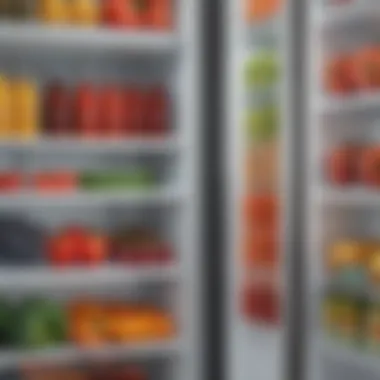Mastering Refrigerator and Freezer Temperature Settings


Intro
In the realm of food storage, maintaining appropriate temperatures in refrigerators and freezers is of utmost importance. Not only does it play a significant role in preserving food quality, but it also ensures food safety for consumption. Understanding the right temperature settings can equip culinary enthusiasts with the knowledge to enhance their cooking experience while minimizing food waste.
Many people are unaware that the optimal temperature for a refrigerator is typically at or below 40°F (4°C), while freezers should maintain a steady temperature of 0°F (-18°C). Deviating from these temperatures can invite a host of problems, including bacterial growth, spoilage, and loss of flavor in food items.
This exploration delves deeper into these critical temperature guidelines, examining popular misconceptions and presenting practical advice on how to manage and optimize appliance settings effectively.
From busy families to culinary adventurers, understanding these temperature settings is key to both delicious meals and overall food safety.
Prelude to Refrigerator and Freezer Settings
In today's fast-paced environment, maintaining proper refrigerator and freezer settings is essential for both food quality and safety. Most people overlook this critical aspect of their kitchen. However, the temperature at which food is stored directly impacts its freshness, texture, and safety. This article seeks to uncover the science behind these settings and the benefits of optimal management.
Importance of Proper Temperature Settings
Proper temperature settings inside refrigerators and freezers are fundamental to prolonging the shelf life of food. An ideal refrigerator temperature should hover around 37°F (3°C), while freezers should be maintained at 0°F (-18°C). This minimizes the risk of foodborne illnesses caused by bacterial growth. When food is kept at appropriate temperatures, nutrients are preserved, flavors are intact, and waste is reduced.
Maintaining accurate temperatures also prevents spoilage. Food left in warmer conditions can spoil faster, leading to financial loss and health concerns. The right settings ensure the natural integrity of various foods, making them safe to consume as long as possible. Busy individuals will appreciate that these adjustments can vastly improve meal prep efficiency.
Additionally, being aware of temperature settings helps in energy conservation. A refrigerator or freezer working harder than necessary may cause higher electricity bills and an increased carbon footprint. Thus, understanding these settings is not only vital for personal health but also for the environment.
Overview of Common Temperature Misconceptions
There are common misconceptions regarding refrigerator and freezer temperatures that can lead to improper food storage practices. One prevalent belief is that setting the refrigerator colder will preserve food better. In reality, temperatures below freezing can lead to freezer burn, which damages food quality without actually preventing spoilage.
Another myth is that a refrigerator only needs to be cold enough to chill food. While this is true, it ignores the essential temperature ranges required to combat specific pathogens. Furthermore, some individuals assume that frost in a freezer indicates that the appliance is working properly. In fact, excessive frost can obstruct proper airflow and lead to inefficient cooling.
Understanding these misconceptions is crucial for consumers aiming to optimize their kitchen appliances. Gaining accurate knowledge ensures that food safety is prioritized and that overall culinary experiences are enhanced.
Recommended Temperature Ranges
Understanding the recommended temperature ranges for both refrigerators and freezers is crucial for maintaining food safety and extending food shelf life. Improper temperature settings can lead to the growth of harmful bacteria and spoilage, compromising the quality of the food. This section delves into ideal temperatures for refrigeration and freezing, addressing how these factors impact food preservation.
Ideal Refrigerator Temperature
The ideal temperature for most home refrigerators is typically between 37°F (3°C) and 40°F (4°C). Keeping your refrigerator at this range is essential to inhibit bacterial growth. Most pathogens thrive at temperatures above 40°F. Therefore, setting your refrigerator cooler than this limit significantly protects against contamination.
In setting the temperature, the refrigerator's location within the kitchen can also be influential. If the appliance is installed in a warmer area, adjustments may be necessary to achieve a suitable internal climate.
- Ensure to check the thermometer inside the fridge, as built-in gauges can sometimes be misleading.
- Aim for proper air circulation within the refrigerator to maintain a consistent temperature.
Maintaining an optimal environment not only preserves the quality of food but also enhances the efficiency of the appliance. If the refrigerator is consistently functioning in the desired range, energy consumption is reduced. This means lower electricity bills, which is an added benefit for households.


Optimal Freezer Temperature
For freezers, the optimal setting is 0°F (-18°C) or lower. This temperature effectively halts bacterial growth, preserving food for extended periods. While food can technically be stored indefinitely at this temperature, quality may degrade over time due to freezer burn. Thus, it is wise to consume frozen items within recommended timelines.
Regularly checking the temperature ensures that the freezer operates efficiently. If there are any fluctuations, it's advisable to investigate. Issues like air sealing or appliance location may prompt temperature changes.
- Use a freezer thermometer to monitor the environment and make adjustments as needed.
- Be aware that overloading the freezer can obstruct airflow, leading to uneven cooling.
By adhering to the recommended settings, one can significantly reduce food safety risks while maximizing the use of storage space. Optimal temperature ranges are not mere numbers; they are the difference between fresh and spoiled food.
Factors Influencing Temperature Settings
Temperature settings for refrigerators and freezers are not arbitrary but are influenced by various factors that can significantly impact food preservation. Understanding these factors is crucial for culinary enthusiasts who seek to optimize food storage and maintain quality. Proper temperature adjustments are necessary for reassurance that perishable items are safe for consumption while minimizing wastage. Identifying the key elements at play will enhance one’s approach to food safety and storage, ensuring a seamless culinary experience.
Ambient Temperature Effects
Ambient temperature can affect how effectively a refrigerator or freezer performs. The temperature in the environment where the appliance is located impacts how hard the unit has to work to maintain its internal temperature. When the ambient temperature rises, the appliance has to use more energy to offset the heat, which can lead to inconsistencies in temperature achievement. For example, placing a refrigerator near an oven, heating vent, or in a poorly insulated area can cause it to operate less efficiently.
- Optimal placement of the refrigerator is crucial. Avoid placing it near heat sources to maintain stable performance.
- Seasonal changes can also play a role. In warmer months, appliances may require adjustments to cooler settings to attain the ideal temperatures for food preservation.
Understanding how ambient conditions influence your refrigerator or freezer’s inner climate helps consumers make informed decisions about food safety.
Appliance Performance Variability
Each refrigerator and freezer model has unique performance characteristics that can alter the effectiveness of temperature settings. Features such as energy efficiency ratings and technology level, like the presence of smart cooling technologies, affect how well the appliance can maintain its internal climate.
- Maintenance is key. Regular cleaning of coils and ensuring proper airflow can significantly improve efficiency.
- Age of the appliance also plays a role. Older units may not hold temperatures as effectively as newer models, often requiring more frequent monitoring.
Regular adjustments based on appliance performance variability ensure that the food remains fresh despite fluctuating conditions.
Understanding these performance factors allows the consumer to tailor their temperature settings accordingly, thus ensuring optimal food safety and freshness.
Impact of Temperature on Food Safety
Food safety is a topic that concerns everyone, but understanding the relationship between temperature and food safety is crucial for maintaining health. Regulating the temperature accurately in refrigeration and freezing appliances prevents foodborne illnesses. Bacteria such as Salmonella and E. coli can thrive at higher temperatures, leading to potential health risks. By enforcing proper temperature settings, consumers can significantly reduce the chances of pathogen growth.
Keeping food at the right temperature extends beyond just avoiding sickness; it plays a vital role in maintaining nutritional quality. Fruits and vegetables, for instance, can lose their vitamins when exposed to inappropriate temperatures. Thus, it benefits consumers to analyze food safety comprehensively, aligning proper appliance settings with health and food quality.
Understanding Pathogen Growth
The growth of pathogens is a serious concern in food safety. Bacteria multiply rapidly under specific conditions, particularly in the danger zone of 40°F (4°C) to 140°F (60°C). Freezing food keeps it out of this range, effectively halting bacterial reproduction. Conversely, if refrigeration fails or is set incorrectly, food can reach unsafe temperatures, increasing the risk of contamination.
Food safety relies not just on constant temperatures but also on appropriate storage practices. For example, keeping raw meats at the lowest shelf prevents juices from dripping onto other foods, minimizing cross-contamination. Such practices contribute positively to food safety overall.


"Proper management of refrigerator and freezer temperature can be a key factor in preventing foodborne illnesses."
Food Spoilage Dynamics
Food spoilage is another critical aspect linked to temperature settings. Various factors influence how food deteriorates, including moisture levels, time, and temperature. Bacteria that cause spoilage can also thrive when the temperature is incorrect, causing food to degrade rapidly.
For optimal preservation, one must store food at proper temperatures. Spoiled food not only affects health but can also lead to waste, showcasing the need for scientific understanding of spoilage mechanisms.
Here are a few common signs that indicate spoilage due to temperature issues:
- Off odors: Comprising a change in smell can signal spoilage
- Texture changes: If fruits or vegetables become mushy or overly soft
- Color shifts: An unusual color change often hints at spoilage.
Being vigilant about temperature can thus prevent food waste and protect consumers' health. Recognizing the direct link between temperature, pathogen growth, and spoilage enables a more educated approach to food management.
Maintaining Appropriate Settings
Maintaining appropriate temperature settings in a refrigerator and freezer is critical for food safety and quality preservation. If temperatures are too high or low, food can spoil or deteriorate, potentially leading to health risks or waste of resources. Understanding how to maintain these settings involves a few key elements, including knowing how to measure temperatures accurately, adjusting them according to various needs, and performing regular maintenance on the appliances.
Learning to Use the Thermometer
Using a thermometer effectively is the first step in maintaining optimal temperature settings. While many refrigerators have internal thermometers, they are not always accurate. Therefore, an independent appliance thermometer should be placed in both the refrigerator and freezer sections. It allows for a more precise measurement of the actual internal temperature.
- Placement is Key - The thermometer should be placed in the center of the refrigerator or the freezer, away from the walls and not touching any food items. This positioning ensures an accurate reading of the ambient temperature rather than a localized one.
- Checking Regularly - Regular checks of the thermometer can help identify any temperature imbalances. It is advisable to review thermometer readings every few days, especially if there are noticeable changes in food quality or ice buildup.
- Adjusting Settings - If the thermometer indicates that the temperature is outside the recommended ranges, adjustments to the settings are necessary. For refrigerators, the ideal temperature is around 37°F (3°C), while freezers should be at 0°F (-18°C). Knowing how to make these adjustments will ensure that food remains safe for consumption.
Regular Maintenance Tips
Proper maintenance of refrigerators and freezers extends their longevity and improves efficiency. Here are some practical tips that every user should follow:
- Clean the Coils - Dust and debris accumulation on condenser coils can hinder cooling efficiency. Regular cleaning of these coils, at least every six months, is essential for optimal operation.
- Check Door Seals - Door gaskets should be checked regularly to ensure they create a proper seal. Any wear or damage can lead to temperature fluctuations, causing food spoilage.
- Defrosting - If frost builds up in the freezer, it can obstruct airflow, making the appliance work harder. Frequent defrosting, depending on usage, is important to maintain efficiency and temperature control.
- Keep Temperature Monitored - Though thermometers are crucial, also consider monitoring any abnormal sounds or behaviors of the unit. Unusual noises might indicate mechanical issues that need addressing.
- Utilize the Space Wisely - Avoid overpacking your refrigerator and freezer, as it can impede air circulation, leading to uneven temperatures. Leave space for air flow around items.
Proper maintenance not only helps food safety but can also save on energy bills.
In summary, maintaining appropriate settings is about diligence and routine. If temperatures are managed effectively, food safety and quality can be assured, ultimately enhancing the cooking and dining experiences.
Common Refrigerator and Freezer Issues
Understanding common refrigerator and freezer issues is vital for anyone aiming to preserve food quality and ensure safety. These appliances are central to modern food storage, and problems can disrupt their intended function. Identifying potential issues can prevent spoilage, promote better food safety, and even increase energy efficiency. Addressing these matters promptly contributes to a more stream lined kitchen experience and savings on grocery bills.
Temperature Fluctuations
Temperature fluctuations in refrigerators and freezers can lead to significant food spoilage. These fluctuations can occur for various reasons, including frequent door openings, overloading, or malfunctioning thermostats. An appliance subjected to constant temperature changes may not maintain the desired coolness needed for optimal food preservation.
To help mitigate this risk, consider the following:


- Keep the door closed as much as possible. Each time the door opens, warm air enters, and it takes time for the appliance to cool back down.
- Manage the load properly. Avoid cramming too many items into the unit, as this can obstruct airflow, leading to uneven cooling.
- Monitor the temperature regularly using an appliance thermometer. This ensures that the fridge maintains an adequate temperature of around 37°F (3°C) and that the freezer remains at 0°F (-18°C).
If you notice persistent temperature variations, it may be wise to consult an appliance technician or review the user manual for further troubleshooting steps.
Frost Build-Up in Freezers
Frost build-up in freezers is another common issue that can compromise storage efficiency. When frost accumulates, it can reduce the total available space and hinder airflow. This often leads to uneven freezing, resulting in the potential spoilage of certain goods. Beyond just storage complications, excessive frost can impact the appliance's overall energy consumption, as it works harder to maintain cold temperatures amidst a thick frost layer.
To manage and prevent frost build-up, follow these tips:
- Regularly defrost your freezer, especially if it is not frost-free. Doing so every few months can help maintain efficiency.
- Check the door seals for any damage or debris. Poor seals allow humid air to enter, causing frost to form.
- Limit door openings. Every opening allows moisture to enter, which contributes to frost accumulation.
By being attentive to these common issues, one can enhance the performance of refrigerator and freezer appliances. Proper maintenance not only legs to better food storage but also prolongs the life of these essential units.
The Role of Temperature in Meal Prep
Understanding temperature settings is crucial for meal preparation in the context of storing ingredients and ensuring food safety. Proper temperature management not only preserves freshness but also minimizes the risk of foodborne illnesses. Adequate temperature control can transform your culinary experience, enabling you to serve high-quality meals that maintain their intended flavor and texture.
Prepping Foods for Storage
When preparing foods for storage, it is vital to ensure that each item is maintained at an appropriate temperature. The following are key points to consider:
- Immediate Refrigeration: After cooking or purchasing perishable items, they should be refrigerated immediately. This slows bacterial growth and preserves quality.
- Cool Before Storing: Hot foods should cool down to room temperature before placing them in the refrigerator. This prevents raising the internal temperature of the fridge, which can affect other stored items.
- Proper Packaging: Use airtight containers or wrap items securely to reduce exposure to air. This not only preserves moisture but also prevents freezer burn in the freezer.
- Labeling: Always label your stored foods with the date and contents. This will help you track how long items have been in storage and ensure you use them in time.
Defrosting Guidelines
Defrosting is as important as storing food at the right temperature. Following proper guidelines helps maintain food safety and quality:
- Refrigerator Method: The safest way to defrost food is in the refrigerator. This keeps the food at a consistent, safe temperature while it thaws. It may take longer, but it is the most effective method.
- Cold Water Method: If time is limited, place the food in a sealed bag and submerge it in cold water. Change the water every 30 minutes to keep it cold.
- Avoid Room Temperature: Never defrost food at room temperature. This practice can allow harmful bacteria to grow on the outer layer of the food.
- Cook Immediately: After using the microwave for defrosting, cook the food right away. Microwaves can partially cook the food, increasing the risk of bacteria growth.
Proper temperature management during meal prep sets the foundation for a safe and enjoyable dining experience. Being mindful of how food is stored and defrosted can significantly improve food quality and reduce health risks.
By implementing these practices, culinary enthusiasts can enhance the overall quality of their meals while ensuring safety. From initial prep to serving, temperature plays a critical role in achieving optimal food preservation.
End
Understanding the optimal temperature settings for refrigerators and freezers is crucial for anyone who values food safety and quality. This article has delved into various aspects of temperature settings, emphasizing their implications for food preservation, safety, and overall culinary experiences. It is important to grasp how these aspects intersect with daily meal preparation and storage practices.
Summary of Key Points
- Proper temperature settings in refrigerators should ideally be around 37°F (3°C), while freezers should maintain a temperature of 0°F (-18°C).
- Understanding ambient conditions and appliance performance contributes significantly to maintaining desired temperatures, thereby optimizing food safety.
- Attention to pathogen growth and food spoilage dynamics is essential for preventing foodborne illnesses.
- Regular monitoring using thermometers, along with routine maintenance, ensures that appliances function efficiently.
Final Recommendations for Consumers
To enhance food safety and quality, consumers should consider the following recommendations:
- Regularly check your refrigerator and freezer temperatures. Invest in a reliable thermometer to avoid any discrepancies in actual and set temperatures.
- Be mindful of food placement. Store items properly within units; avoid overcrowding to allow for proper air circulation.
- Keep appliances clean and well-maintained. Schedule regular cleaning to prevent issues like frost build-up and ensure efficient operation.
- Educate yourself about food safety practices. Understand the signs of spoilage and reheating guidelines to minimize waste and protect health.
By implementing these guidelines and recommendations, individuals can significantly improve their food storage practices, which not only enhances the culinary experience but also contributes to safer food consumption.







